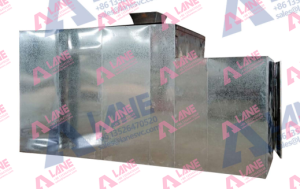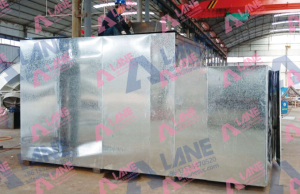What is a Horizontal Fertilizer Fermentation Tank?
A Horizontal Fertilizer Fermentation Tank is a specialized piece of equipment used to facilitate the aerobic fermentation of organic materials, such as animal manure, crop residues, and other organic waste. Unlike traditional composting methods, which can be time-consuming and space-intensive, this tank is designed to accelerate the decomposition process, producing high-quality compost in a fraction of the time.

Key Features:
- Horizontal Design: Maximizes space efficiency and ensures uniform fermentation.
- Using 304 stainless steel, with strong anti-corrosion ability and long-lasting durability.
- Aeration System: Provides consistent oxygen supply, crucial for aerobic fermentation.
- Temperature Control: Maintains optimal conditions for microbial activity.
- Mixing Mechanism: Ensures even distribution of heat and oxygen throughout the material.
- Insulated Structure: Retains heat, speeding up the fermentation process.
- Sealed Environment: Reduces odor emissions and prevents contamination.
How the Horizontal Fertilizer Fermentation Tank Works
The horizontal design of the tank allows for even distribution of heat and oxygen, essential elements for the aerobic fermentation process. Here’s a step-by-step look at how it operates:

- Loading the Tank
Organic materials, such as animal manure or crop residues, are loaded into the tank. These materials are typically pre-shredded to increase surface area, which helps speed up the fermentation process.
- Aerobic Fermentation Begins
Once the tank is loaded, the aerobic fermentation process begins. The tank’s built-in aeration system ensures that the organic material is consistently supplied with oxygen, which is necessary for the growth and activity of aerobic microorganisms. These microorganisms break down the organic material, releasing heat as a byproduct.
- Temperature Regulation
As the microorganisms work, the temperature within the tank rises. The Horizontal Fertilizer Fermentation Tank is equipped with a temperature control system that maintains the ideal conditions for fermentation, typically between 55°C and 65°C. This high temperature helps kill pathogens and weed seeds, resulting in a more hygienic and stable compost product.
- Mixing and Turning
To ensure uniform fermentation, the tank is equipped with a mixing mechanism that periodically turns the organic material. This mixing action distributes heat and oxygen evenly throughout the tank, preventing the formation of hot spots and ensuring that all the material undergoes fermentation.
- Insulation and Heat Retention
The tank’s insulated structure helps retain the heat generated during the fermentation process. This feature is crucial for maintaining a consistent temperature, even in colder climates, and contributes to a faster and more efficient composting process.
- Odor Control and Sealed Environment
One of the significant advantages of the Horizontal Fertilizer Fermentation Tank is its sealed environment, which helps control odors that are typically associated with composting. The closed system also prevents the entry of pests and reduces the risk of contamination from external sources.
- Completion of Fermentation
Depending on the material and desired final product, the fermentation process can take anywhere from a few days to a few weeks. Once the process is complete, the resulting compost is rich in nutrients and ready for use as organic fertilizer.
Technical parameters:
| MODEL |
POWER
(KW) |
FERMENTATION TIME (h) |
VOLUME
(m³) |
REDUCER |
DIMENSION
(mm) |
| LAHF-3F |
3 |
7-10 |
3.1 |
ZQ – Reducer |
3500*1550*2200 |
| LAHF-5F |
11 |
7-10 |
5.4 |
ZQ – Reducer |
4700*1850*2350 |
| LAHF-10F |
5.5 |
7-10 |
10 |
ZQ – Reducer |
3500*2400*2900 |
| LAHF-20F |
11 |
7-10 |
20 |
ZQ – Reducer |
5500*2600*2900 |
| LAHF-30F |
15 |
7-10 |
30 |
ZQ – Reducer |
6000*2900*3500 |
Advantages of Using a Horizontal Fertilizer Fermentation Tank

- Efficiency and Speed
Traditional composting methods can take several months to produce usable compost. In contrast, the Horizontal Fertilizer Fermentation Tank can complete the process in a matter of weeks, significantly increasing production efficiency.
- Space-Saving Design
The horizontal design of the tank allows it to be installed in spaces where traditional compost piles would be impractical. This compact design is particularly beneficial for urban farms or operations with limited space.
- Enhanced Quality Control
The tank’s temperature and oxygen control systems ensure that the fermentation process is consistent, resulting in a high-quality compost product every time. This level of control is difficult to achieve with open-air composting.
- Hygienic and Safe Production
By maintaining high temperatures throughout the fermentation process, the tank effectively kills harmful pathogens and weed seeds, producing a safer, more stable fertilizer that can be applied directly to crops.
- Odor Management
The sealed environment of the Horizontal Fertilizer Fermentation Tank drastically reduces the odors typically associated with composting. This makes it an excellent choice for operations located near residential areas or those looking to minimize their environmental impact.
- Scalability
Whether you’re running a small farm or a large industrial operation, the Horizontal Fertilizer Fermentation Tank can be scaled to meet your production needs. Its modular design allows for multiple units to be installed side by side, increasing capacity as required.
- Environmental Benefits
The tank’s design minimizes the release of greenhouse gases, such as methane, that are often produced during traditional composting. By using a controlled aerobic process, the Horizontal Fertilizer Fermentation Tank contributes to a more sustainable and environmentally friendly fertilizer production method.
Applications of the Horizontal Fertilizer Fermentation Tank

The versatility and efficiency of the Horizontal Fertilizer Fermentation Tank make it suitable for a wide range of applications:
- Animal Manure Processing: Livestock farms can use the tank to process animal manure into high-quality organic fertilizer. This not only helps manage waste but also creates a valuable product that can be used on the farm or sold commercially.
- Crop Residue Composting: After harvest, crop residues can be composted in the tank, turning what would otherwise be waste into a nutrient-rich fertilizer that can be returned to the fields.
- Organic Waste Management: Food processing plants, municipal waste facilities, and other operations that generate organic waste can use the tank to convert waste into compost, reducing landfill use and creating a valuable byproduct.
- Commercial Fertilizer Production: For businesses in the fertilizer industry, the Horizontal Fertilizer Fermentation Tank offers a reliable and efficient way to produce large quantities of high-quality organic fertilizer.
Conclusion
The Horizontal Fertilizer Fermentation Tank represents a significant advancement in the field of organic fertilizer production. By providing a controlled, efficient, and scalable environment for aerobic fermentation, this machine ensures that raw organic materials are transformed into high-quality compost quickly and effectively.
For farmers, waste managers, and commercial fertilizer producers, investing in a Horizontal Fertilizer Fermentation Tank offers numerous benefits, from increased efficiency and space savings to enhanced product quality and environmental sustainability. This machine is not just a tool—it’s a key to unlocking the full potential of organic waste, turning it into a powerful resource for sustainable agriculture.

![]()

